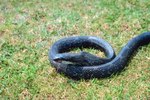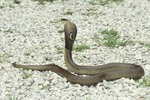
The Texas Hill country is a rocky, elevated region on the eastern side of the Edwards Plateau. Of the 77 snake species native to the state, 42 live in the Hill Country region. Most species native to the area are harmless, but six dangerously venomous snakes do inhabit the Hill Country.
Small Species
Few snake species in Texas Hill Country exceed 3 feet in length, and many are less than 2 feet. Commonly seen species include the earthworm and slug-eating ringneck (Diadophis punctatus), brown (Storeria dekayi) and red-bellied snakes (S. occipitomaculata). Lesser seen species include several types of black-headed snake (Tantila sp.), two threadsnakes (Leptotyphlops sp.) and the long-nosed snake (Rhinocheilus lecontei). Rough green snakes (Opheodrys aestivus) are thin, green snakes that live in trees and consume insects.
Watersnakes, Garter Snakes and Ribbon Snakes
Three frog- and fish-eating watersnake species of the genus Nerodia live in the Hill Country; diamondback (N. rhombifer), plain-bellied (N. erythrogaster) and banded water snakes (N. fasciata). Three types of garter snake (Thamnophis sp.) are common in the area as well, and though they're not as strongly tied to the water as true watersnakes are, they are closely related to them. One species of ribbon snake (T. proximus) is also native to the area. Ribbon snakes and garter snakes can be distinguished by the upper lip scales, which have black markings in the case of garter snakes, but are immaculate in the case of the ribbon snake.
Prowling Species
Several prowling species hunt the wide open areas of the Hill Country for prey. Three whipsnakes (Masticophis sp.) inhabit the area, including the very large coachwhip (M. flagellum), and primarily consume lizards. Eastern racers (Coluber constrictor) are also prowling. Lizard-eating snakes of the region that include insects and other snakes in their diet. The largest of the prowling species is the western indigo snake (Drymarchon corais), which may exceed 8 feet in length.
Large Constrictors
The Hill Country holds a number of large, non-venomous, constricting species. Rat snakes of the area include Trans-Pecos ratsnakes (Bogertophis subocularis), as well as three members of the genus Pantherophis: Baird’s (P. bairdi), eastern (P. obsoleta) and prairie ratsnakes (P. guttatus). Like ratsnakes, gopher snakes (Pituophis catenifer) also constrict their rodent prey, while grey-banded (L. alterna) and common kingsnakes (Lampropeltis getula) consume snakes and lizards. Milksnakes (L. triangulum) are kingsnake relatives that consume rodents and lizards. Glossy snakes (Arizona elegans) don’t attain the size of some of the rat and gopher snakes, but they also constrict their rodent and lizard prey.
Venomous Snakes
Three rattlesnakes -- banded rock (Crotalus lepidus), western diamdonback (C. atrox) and black-tailed rattlesnakes (C. molossus) -- are found in the Hill Country, where they eat lizards, rodents and birds. Two other pit vipers, the cottonmouth (Agkistrodon piscivorous) and copperhead (A. contortrix) are often found near permanent water sources. The Texas coral snake (Micrurus tener), a relative of cobras and mambas, is a small, nocturnal snake-eating species.
References
Resources
Photo Credits
-
Jupiterimages/Photos.com/Getty Images




